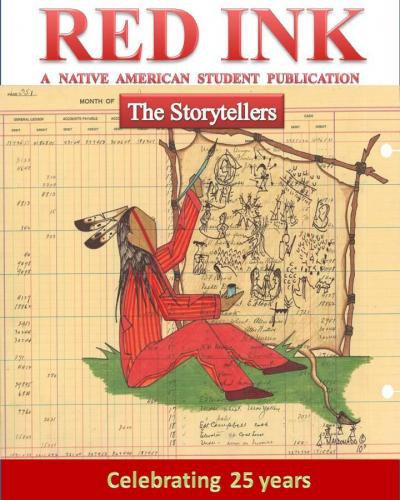RED INK Journal: Preserving, Promoting an Indigenous Voice
For the sake of the land, culture, and community.
—Simon Ortiz
When I spoke to the managing editor and two subject editors of RED INK: International Journal of Indigenous Literature, Art, & Humanities, I realized that its publication is not just a scholarly project; it is an opportunity to preserve the Indigenous voice. As ASU English Regents’ Professor Simon Ortiz expressed, “Native American literature as a voice in this country and beyond is vital.” Ortiz discussed the will, commitment, and determination of those involved with RED INK Journal, echoed by the two graduate students serving as editors—Travis Franks (Non-fiction Editor) and Kenneth Dyer-Redner (Fiction Editor). During our conversations, I not only heard their words, I could almost feel their commitment to this important work.
Collaboration and Commitment
Approximately two years ago, Ortiz committed to bringing RED INK Journal to ASU. Under his direction, those at ASU involved with the journal build on a strong reputation and a long tradition of excellence. RED INK was published as RED INK Magazine out of the University of Arizona since 1982. Ortiz expressed his team’s collaborative desire and interest to keep the journal growing.
RED INK Journal is “a bi-annual periodical journal dedicated to promoting Indigenous literature, art, and humanities through the voice of Indigenous (Native) peoples in relation to identity, land, culture, and community.” To this end, the journal accepts submissions in the form of creative writing, scholarly works, art works, humanities essays, and narrative discourse.
While the journal is distinctly literary, it has a strong interactive mission. Ortiz believes in the importance of extending an Indigenous voice into the community—for example, by introducing Indigenous storytelling, poetry, and discussions of Native American history in K-12 settings. In this sense, Ortiz shared that both the literary and outreach missions of the journal “preserve Native literature as part of the American voice.”
Generous Mentorship
RED INK Journal is part of a larger project on which Ortiz is collaborating with Professor of English James Blasingame, an expert in literature for youth. This partnership is key, since including young people is necessary to any effort promoting revitalization of Indigenous culture. RED INK Indigenous Initiative for All, as the umbrella project is known, has a stated purpose “to provide the world with access to Indigenous creative, artistic, and intellectual expression and collaborative experiences, to promote discourse among Native and non-Native communities about Indigenous issues, and to increase access to higher education for Indigenous communities.” Ortiz and Blasingame are currently in the planning stages of a launch event for the initiative to take place this April.
The journal remains at the heart of the RED INK Initiative, and its staff is firmly committed to furthering its inclusive ideals—exemplified by Ortiz himself. Dyer-Redner shared that before coming to ASU, he had reached out to Professor Ortiz for advice through email and “was surprised that Simon was so willing to help.” Dyer-Redner continued, “If Simon Ortiz was not at ASU, I don’t think I would have applied to graduate school. Luckily for me, he was, and I took the plunge to extend my work as a scholar and a writer—and now, influenced by the AIS (American Indian Studies) program, as an activist.”
Franks had similar sentiments: “The opportunity to work with Simon Ortiz is really special, because he’s so well-known in the literary world. He’s been incredibly kind and inclusive to me since I got to ASU. Learning from him as a professor, as Managing Editor, and mentor has opened doors for me.”
Dyer-Redner said that in addition to his editorial role, he is also tasked with external outreach. "I view my work with RED INK Journal as a responsibility to Indigenous people." As the journal continues to grow, Franks explained that the journal is looking for submissions from global Indigenous people—so that Indigenous voices are represented on an international scale. This would not only widen the scope of the journal but will aid in the preservation of the global Indigenous perspective.
Looking to the Future
While housed in the Department of English, RED INK Journal is self-sufficient. To grow the journal and associated community projects, there is a strong need for more financial support. As Dyer-Redner shared, “We (the editors and staff) are hoping that RED INK Journal snowballs into a major publication.” To accommodate this vision, there is a need for more office space, work space, and storage space—not only to house monthly meetings but to archive past issues and documents associated with the journal. Funding is also needed to pay editors and staff members, create community-based initiatives, print and ship biannual issues of the journal, and support ongoing projects and fundraising efforts associated with the larger interactive mission and goals of the RED INK Indigenous Initiative for All.
According to Dyer-Redner, the journal is receiving great submissions and “things are going in the right direction.” The body of work in the forthcoming issue (April, 2016) represents a mix of people in the Indigenous world and these contributions will continue to grow in the coming months. One highlight of the forthcoming issue is the inclusion of Franks’ recent interview with Sherman Alexie—just one example of the experiential knowledge that graduate students are getting through their participation with RED INK.
I consider it an honor to have learned more about RED INK, to understand its mission and scope; and most importantly, to see the integrity, heart, and dedication of those affiliated with it.
To support the RED INK Indigenous Initiative for All, please contact Ortiz at 602-438-9325 or [email protected]. You can also visit redinkinternational.org to support the journal through advertising or visit its Facebook page to keep up with current news.
—Meghan Bacino

